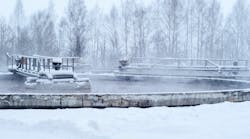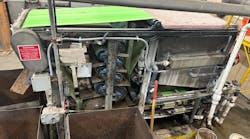Installation of a new system that grinds, washes, compacts, and dewaters bar screenings at the Meriden Conn. Water Pollution Control Facility has dramatically reduced organic content and overall volume, eliminating remote landfill disposal costs, while also significantly reducing handling needs and odor, according to the plant’s manager.
The Screenings Washer Monsterä device, installed last May as an alternative to a costly, complex and burdensome procedure forced by closure of an adjacent landfill, is manufactured by JWC EnvironmentalÒ of Costa Mesa, Calif, which has a patent pending for the technology.
“Before the landfill adjacent to our site was closed, all we had to do was haul the screenings over there in our own 8 cu. yd. truck,” recalled Robert T. Mercaldi, assistant director, Water Pollution Control Division, Dept. of Public Works, and manager of the 11.6 mgd plant, which is a two-time winner of EPA Region 1’s Operation and Maintenance Excellence Award.
“After the closure, we had to find a company licensed to haul over the road, certify testing for a list they gave us of screenings parameters to be analyzed, rent a 15 cu. yd. specially-lined dumpster for $1,200 a month, and pay landfill drop-off charges ranging from $40-50 a ton at sites in Ohio, Pennsylvania, and New Jersey,” he said. “Meanwhile, we had a complex new task to take care of in the plant, moving around solids heavily loaded with organics, with heavy odor, and requiring double and triple handling.”
“We called other plants who were in the same situation, and it didn’t seem anyone had a great solution,” Mercaldi continued. “We heard that a grinder/shredder already in use in digesters might be used at the front end of the stream in the inlet, but we were concerned about possible re-accumulation of solids in the digester, causing plugging of pumps and heat exchangers. The state didn’t like it either, and strongly discouraged us. But we couldn’t go on like we were, and were ready to award a bid to JWC Environmetal for that solution, when we found out they had developed a new piece of equipment for this situation.”
“We installed the new unit without the need for any outside contractors, including all wiring and controls, and haven’t had any operational problems,” he stated. “We just had to re-torque the drum head for the augur conveyor one time when the LED light told us to. It’s basically totally unattended. The control panel is routinely checked daily by regular plant operators, who have a manual to follow if they need it, and we’ll be using our regular maintenance mechanics for biannual checks of gear oils and transmission fluids.”
“I was a little concerned when nothing had come out the end for the first five days after startup, but I also noticed there wasn’t any odor,” he remembered. “Finally, a very dry solid, resembling shredded newspaper, extended 6 or 8 in. above the exit chute, like ashes at the end of a cigarette. That falls off into a bin, and we bag it up for disposal as Special Waste, and very viable use in trash-to-energy plants. The Connecticut Dept. of Environmental Protection is working with the trash-to-energy plants to have the material re-classified as Municipal Solid Waste.”
“We’ve been able to reduce the weight of our bar screenings from 8 tons per month to 660 lb per month, and their volume was reduced from 15 cu. yd./mo. to one cu. yd./mo.,” he concluded. “In addition to eliminating the cost for the out-of-state dumping, and all that extra work we were doing with a backhoe, front-end loader, wheelbarrows, and the dumpster, we no longer need the bar screen at our pump station. All the screenings formerly removed there can be pumped to the inlet building where the new unit is.”
Mercaldi said his two remaining bar screens are fine types, with 1-1/2” spacing, and automatic raking systems. A single chute receives scrapings from each screen, with effluent water piped in to push them into the Screening Washer Monsters square-funnel hopper. They then move through a grinder, and into a wash box, where a high-pressure spray cleans the ground up particles and washes out organics. Compression and dewatering follows, with more water squeezed out in the tapered exit chute. He adds the final product has the appearance of shredded newspaper, although considerably compacted.
He said the unit is driven off the bar screen, with a vertical float tripping the switch as the level rises. Fifteen to twenty minute cycles are repeated as needed. Plant backflow water is used to wash screenings down the chute, and potable water is used for the spray in the washbox.
JWC Environmental reports similar success for the new product at a western location, where moisture content of rags and screenings coming off a bar screen was reduced from 86.2% to a 47.2% cake, and there was also a large reduction in the amount of organics. In addition, operations staff there had previously needed to dump rags and screenings on a daily basis, and now need to do it only once every two weeks, with a coincident 30% reduction in hauling costs.
The company says its Screenings Washer Monster is a self-contained unit that can effectively process screenings that have been captured by bar screens or other screenings removal devices. Discharge is said to be virtually free of organic(fecal) matter, with the exit plug typically 40-50% dewatered, and reduced in volume by about 75-80%.
Captured solids are diverted from a hopper through a grinder and then passed to an auger, which washes and separates soft organics from plastics, paper, and other undesirable elements. Grinding then exposes more surface area for spray water to further clean out unwanted solids.
Organics and wash water pass through the augur’s perforated trough, and are returned to the plant’s waste stream. Remaining material is conveyed, compacted, dewatered, and discharged as cake.
A controller accepts the input signal as synchronized with a screen or conveyor, and the augur operates automatically in an on/off cycle. During normal operation, the grinder operates continuously, or is sequenced to run only when the controller senses a signal from the screen or conveyor.
Screenings capacities are 150 cu.ft.(2.55 cu. m.)/hr for a 10 HP(7.5 kW) unit, or 25 cu. ft.(0.71 cu. m.)/hr for a 5 HP(3.7 kW) alternative. The unit is available in a grinder-less version for use with the company’s Auger MonsterÒ system.
For further information, contact JWC Environmental, Costa Mesa, CA 92626, Tel. 949/833-3888, fax 949/833-8858, [email protected], www.jwce.com
